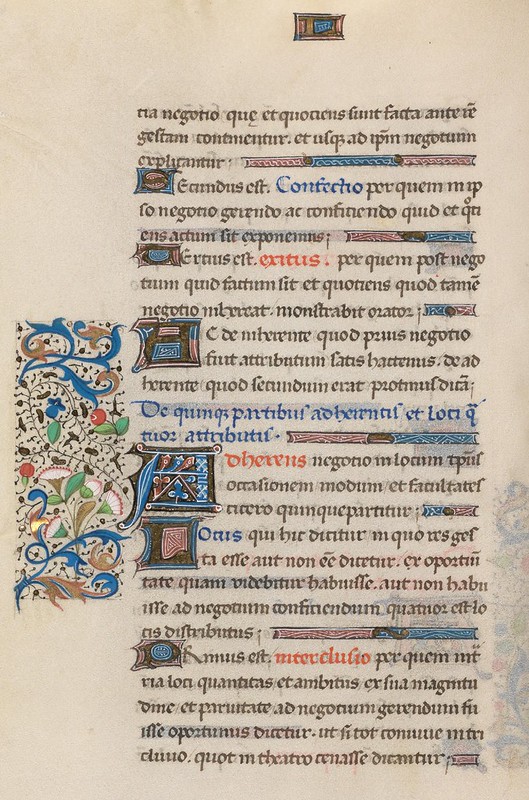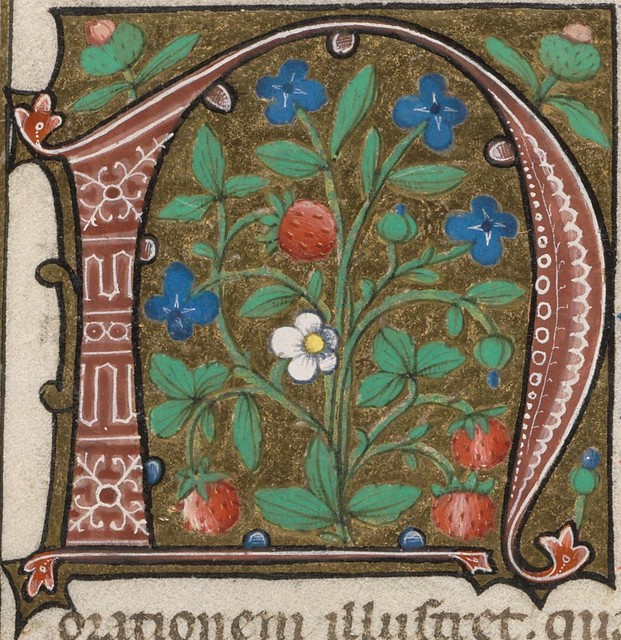
George Clulow (undated)
"Against starry sky, bare-breasted Egyptian goddess wearing ankh pendant and holding sheaf and quill; ouroboros (snake with its tail in its mouth) surrounded open book with owner's initials, book press and ink balls. Motto on banner: Lux in tenebris (Light in the shadows)"

Carolta Campins - bookplate by Joaquim Renart, 1904
"Tree eradicated (showing roots) with shield upon which is a lyre."

Denver Athletic Club Library - bookplate by Leota Woy, 1904
"Within triangular space, bald man in waistcoat and checkered pants
reads a book; below, a man runs with football, 'DAC' on his jersey."

Henrietta Jane Adeane - bookplate by Harry Soane, 1883
"Printed in black and red. Within a picture frame, a lozenge escutcheon: vert (green) a chevron or (gold) charged with 3 mullets (stars) sable (black), between three griffin's heads erased or (gold). Banner with originator's name"

Robert Barclay - armorial (undated)
"Crest: a dove with an olive branch in itsmouth, perched on a straight wreath.Motto: Cedant arma = Let military power give way"

Barry H Jones (undated)
"Oil lamp, crossed quills, decorative border."

Arthur Wellington Clarke (1898)
**Who Borrow Books and Soon Restore
May Come Again and Borrow More**
"Armorial crowned eagle rising erased, above ledge
with books, scroll, ink pot and quill, microscope"

Mary Alice Ercolini - bookplate by SE Blake (undated)
"Japanese ukiyo'e scene with three women in a room.
Vignette lower left.
Note: Discolored by collector's glue."

F Bargallo - bookplate by André Henry(1895)
"Cipher: FB; books, music, portfolio of fashion plates; flower; snake and cup; Motto: Omnis homo mendax = Every man is a liar; In malis venenum, in mediocribus somnus, in egregiis solamen."

Georges Goury - bookplate by Georges Demeufe (undated)
"The motto, "Fert in omnia rutubam et tristitiam terribilis amor" (In all thing terrible love brings trouble and sadness"); depicts a man hanging from a gallows and a night landscape with trees, bats, and a crescent moon."

H Danreuther - bookplate by Edmond des Robert
"Coat of arms. Armorial shield Crest: a woodsman holding an uprooted tree (also depicted on shield). Motto: Quantum est quod nescimus (How little we know). Multicolored. The motto was previously used by the Dutch scholar Daniel Heinsius (1580-1655)"

James T Tarbotton - bookplate by C Helard (undated)
"Raised arms hold uprooted oak tree with
owl in upper branch. Portrait bottom right."

James Henry Darlington - bookplate by Louis Rhead, 1902
"Two women (Theology and Science) shake hands under symbol of the Holy Spirit"

Count Karl Emich of Leiningen-Westerburg - bookplate by A de Riquer, 1903
"Dramatic depicition of bird's head"

Max Harrwitz - bookplate by SB (undated)
"Putto with open book; another putto on
chair of books; central tree with shield and motto.
(Harrwitz was a rare book dealer and publisher in Berlin)"

Pio Freixa Aulet - bookplate by José Triadó (undated, ~1905)
"Town in winter landscape; shield with bars and wing."

Robert Hall, 1902
"Interior with wall of books, large reading table with
books (including open illuminated manuscript, chairs;
large window looking out onto building with spire tower."

Rudolf Benkard, 1895
Halt! Mein Buch!
Stop! My Book!
"Hand reaches out from cloud to nab a man running past "
a bookshelf with a book (Ex libris album) under his arm.

William Livermore Kingman - bookplate by David McNeely Stauffer, 1898
**I am but a Gatherer and Disposer of other Men's Stuff**
"Man in renaissance garb, with ruff, sash and sword; behind him, shelves of books, scientific instruments, decanter and glass; on the table, an envelope for prints marked 'Gravures', partially unfurled print marked 'H. Goltzius'; ink pot and quill, globe showing western hemisphere; open book resting on two closed books.
Note - Quote is by Sir Henry Wotton (1568-1639), from the preface to his Elements of Architecture (1624); name on print refers to Hendrik Goltzius (1558-1617)"

SA Flint (undated)
"Floral frame with beehive against flint arrowhead in center; spires upper left; musical instruments upper right; books lower left; easel lower right, Motto: Sans hâte, sans repos (Without haste, without rest)"
- The John Starr Stewart Ex Libris Collection (1600+ bookplates) at the University of Illinois Urbana-Champaign.
- See Will's post on 50Watts sampling from the back half of the Ex Libris Collection.
- The World of Ex Libris: A Historical Perspective (via The Wayback Machine)
- Previously on BibliOdyssey:::::::: The Bookplate Book --><-- Assorted Ex Libris --><-- Pratt Ex Libris --><-- Heraldic Bookplates --><-- Oleg Denisenko --><----> AND, generally : bookart








































